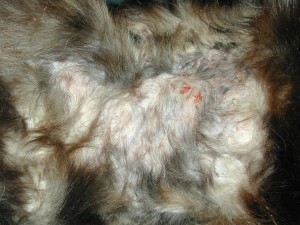
“Atypical” mycobacteria, also called “opportunistic” or “nontuberculous” mycobacteria, are a subset of bacteria belonging to the genus Mycobacteria. These organisms are free living, located throughout the world and are found in damp soil and water. Skin infections in dogs and cats are rare and typically occur when a bite wound or scratch gets contaminated with soil or water containing these bacteria.
The disease is more common in cats then dogs and typically starts as a swelling in the groin. Initially, it is often confused with the more common cat fight abscess but as an atypical mycobacteria infection progresses, the swelling becomes firmer and organizes into lumps or “nodules”. The skin in that area becomes thinner and adheres to the nodules. Multiple small ulcers from which fluid drains then develop. The lesions may or may not be painful. The nodules may increase in size and number locally but in cats that have normal functioning immune systems, the disease does not spread to internal organs and the cats are usually, otherwise healthy.
Diagnosis
Diagnosis is made by either culturing the organism or identifying it on biopsy or cytology from an aspirate. The organism is difficult to grow and identify so consulting with a veterinary dermatologist is recommended. Samples should be sent to a laboratory that has expertise in dealing with these bacteria.
Treatment
Treatment is with antibiotics, ideally based upon culture and sensitivity testing of that particular infection. Typically, pets are on antibiotics for 3 to 12 months. Occasionally, to help in the treatment, infected tissue may be removed surgically. Surgery is not curative and long term treatment with antibiotics both before and after the surgery is essential for cure.
Do you think your cat is suffering from Atypical Mycobacteria? Contact your nearest MedVet dermatologist.
Related Reading:


